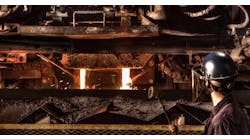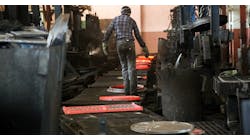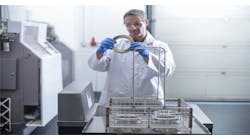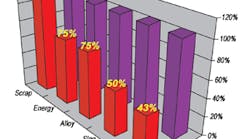By Joseph T. Belsh
This chart illustrates the operating costs for an induction melting furnace as a percentage of similar costs for cupola melting.
Decatur Foundry had relied on cold-blast cupola melting for over 50 years to meet its molten metal needs. But, in 2001 the managers of the family-owned jobbing foundry recognized that cupola melting would no longer support continued growth. Even though the metalcasting industry was entering tough times in 2001, Decatur started a major capital-investment program to switch from cupola to induction melting technology.
“We planned to expand when work was slow, and we prepared for major long-term projects during that time,” Decatur Foundry president Terry Young says. “We felt it was imperative to be ready to take advantage of new opportunities when the economy picked up.
“We had a new business plan and we knew its success would depend largely on our company’s ability to expand its product offerings,” Young explaines further. “But, it had become increasingly apparent to us that the limitations imposed by our continued reliance on cupola melting would be a major obstacle to achieving our plan’s objectives. Induction melting, however, offered the capabilities we required to meet our goals,” he notes.
Limits to growth
Young details that increasing its output of ductile iron products was an important element of Decatur’s emerging business plan at that time, but he says the company also realized such an increase would be difficult with a cupola melting operation. By 2001, gray iron was on its way to becoming a commodity material, with price as its chief selling point. Yet, close to 50% of Decatur’s total output was large gray iron electric motor housings. It was increasingly evident to Decatur’s managers that overseas suppliers would have an advantage in the production of those types of castings.
On the other hand, Young explains that Decatur’s customers showed an increasing demand for ductile iron castings. This trend was documented in market studies projecting an annual, long-term growth rate for ductileiron castings ranging from 2-4%, compared to less than 1% for gray iron. In addition, on a pound-for-pound basis, the value of ductile iron was significantly higher than that of cast gray iron.
“That’s why we had to become more involved with ductile iron,” Young explains. “We had been producing some ductile since 1982,” he recalls, “but cupola melting limited our ability to produce higher value and in-demand engineered ductile iron components. We came to recognize that the cupola would never provide the flexibility we needed to grow our ductile-iron business.” Young observes that using the cupola to produce metal for ductile iron was cumbersome, to say the least. “Desulfurizing with nickelmag and cold metal at the end of the heat was a problem. We were constantly working around the bottlenecks in the melting department,” he explains.
Another major disadvantage of the cupola was the growing capital cost required to keep up with clean-air regulations, along with the costs associated with maintaining all the environmental equipment. Overall, the costs to operate and maintain the aging furnace system were increasing exponentially, as well.
According to maintenance superintendent, Jim Hoback, operating the cupola had become an event in itself, requiring additional maintenance personnel “who would stand around waiting for something to go wrong. And, usually it did,” he says.
In operation, the cold-blast cupola provided Decatur with 60 tons of metal per day, but, because of lining practices, the foundry only melted three days a week. “Customers were always asking ‘Why can’t you pour tomorrow?’,” Young notes. “Fighting production delays and meeting customers’ delivery needs became a huge headache.”
Multiple benefits
The clear benefits offered by an environmentally clean, operationally flexible, and energy-efficient induction melting system that would allow Decatur Foundry to increase ductile-iron production proved decisive. The cupola would be replaced by an induction melting system that also would provide improvements in metallurgical quality, as documented at thousands of other iron melting installations that had switched from cupola melting to induction melting.
The equipment order was placed with Inductotherm (www.inductotherm.com) in mid-2001, and the new induction operation was up and running before year’s end. Induction melting would provide the means for Decatur to carry out its expansion plans.
The new induction melting system at Decatur Foundry included a 1750 kW dualoutput power supply designed to operate two, 3-metric ton furnaces simultaneously. While one furnace melted iron at nearly full power, the second held another full batch at temperature. This allowed molten iron to be tapped as needed for a wide variety of mold sizes. Depending upon the product mix at any particular time, gray iron could be produced in one furnace while the other melted base metal for ductile iron, providing production flexibility that they never experienced with its cupola. The new system also included a pivoting vibratory-charge conveyor able to charge each furnace in turn. The conveyor includes load cells to provide an accurate charge weight.
While the cold-blast cupola provided up to 60 tons of metal per day and operated three days a week, the induction system could provide 70 tons per day of molten gray and/ or ductile base iron, on a five- or seven-day schedule. The increased melting capacity has allowed Decatur to add a second molding shift. It now operates with two 10-hour shifts per day, and has the capacity to increase molding if necessary. “We still have room to grow with the electrics,” Young notes.
More important, he adds, “We are producing a wider range of iron alloys. Customers are looking for pearlitic and ferritic grades of iron with up to 18% elongation. Machinability is better because our chemistries are better and more controllable with the induction furnaces than they ever had been with the cupola.”
Young points out that with the cupola Decatur Foundry never could be sure what carbon or silicon levels, or metal temperature, were going to be. Some cupola melting advocates had cautioned that induction furnaces would generate higher costs for metal additions, but Young reports that the costs of metal additions with the induction melting system are only about 75% of what they had been with the cupola.
The flexibility that the induction melting system brought to Decatur set the stage for much of the success the foundry has achieved in the past five years. “Not only are we producing the higher-value parts that our customers want,” Young says, “but it also allowed us to drop a lot of the low-margin work we had been producing for years.”
Decatur also has achieved a significant improvement in metal quality. “With the induction melting system we’ve eliminated the need for metal filters and have pretty much eliminated slag defects,” he says. “Our risers are smaller than those we had when melting with the cupola. So we’ve improved our overall metal yields as well.”
At the same time, the foundry has achieved a significant reduction in many of its melting operation costs. According to Young, since starting up the induction system, Decatur has lowered overall labor costs by 57% and energy by 25%. “By scheduling our melting operations during off-peak times to avoid excessive demand charges, we’ve been able to reduce power costs from $0.06 to $0.045 per kWh,” he reports. These savings run counter to claims that cupola melting is less labor intensive and generates lower energy costs than induction melting.
Furnace operator Mark Geisinger reports that Decatur easily gets three months of service life (or 4000-5000 tons of iron) per furnace lining, exceeding initial expectations. Geisinger attributes the exceptional silica lining life to close attention to installation and sintering practices during start up, as well as daily care and maintenance.
“We could push it even further,” he says, “but management would rather be cautious than to risk a refractory failure and possible injuries.”
Early concerns unfounded
Young notes that early on there were a number of concerns at Decatur about possible negative impacts from the switch from cupola melting to induction melting.
“With no induction melting experience on staff, we knew we needed to find someone during the planning phase of our modernization program to help direct day-to-day operations,” Young explains. “Fortunately for us, another local iron foundry was cutting its workforce and we were able to attract experienced induction melting personnel from that facility. That bit of luck, along with the direction and training provided by Inductotherm during the start-up phase of the new melting operation, allowed us to get up to speed quickly with induction melting technology,” he says.
While this helped make the transition to induction melting a smooth one, the foundry still planned to keep the cupola operational for an undetermined period “just to be safe,” as it went through its learning curve. This didn’t last long. The first heat from the new induction furnaces was tapped in December 2001. Four months later, it was clear Decatur could phase out its ancient cupola. It has been all induction melting ever since.
Several other factors also prompted early concerns about the conversion.
“We knew up-front that the new melting system would require higher-quality charge materials than the cupola needed,” Young recalls, “and that the cost of these charge materials for induction melting would be about 15% higher than those for the old cupola.”
The surprise, he says, was that these higher charge-material costs were largely offset by related savings.
“Because the charge materials we use for the induction furnace are much cleaner, we’re handling less slag, speeding up our operations, and reducing costs associated with slag disposal,” he says. Young puts these savings at 50% of disposal costs previously associated with cupola melting.
“Also, our customers are looking for metal properties in the 40,000-psi range with a tight grain. With our cleaner charge and the metal homogeneity produced by inductive stirring, we can consistently give that to them today.”
Another, perhaps equally important concern during the planning process was the training required for personnel to achieve the economies and quality improvements that induction melting offered. But, according to Young this training requirement also offered Decatur Foundry the opportunity to bring about a shift in the culture of the company. “The higher level of sophistication inherent in the new melting system gave us the opportunity to demonstrate to existing and potential new customers that ours is a progressive operation, as well as a respected and established metalcasting company,” he says.
Hoback also was concerned about the switch to induction melting. “The cupola was a lot of work, but its operation seemed pretty simple compared to the sophisticated electronics of the new system,” he says. “However, training and back-up support from Inductotherm helped to eliminate those concerns.”
Hoback notes that Decatur’s new melting system requires about one-third of the number of people needed to operate and maintain the cupola. “It wasn’t unusual for as many 17 people to be involved every time we melted and tapped the cupola. Today, with our induction melt shop, we have just five: one person operating the system, two iron pourers, one forklift truck driver and a foreman. I don’t have any maintenance people hanging around like we used to have with the cupola,” he says.
“Maintenance people are always available when they are needed, but now we concentrate more on preventive maintenance with the foundry,” Hoback reports. “It’s a more reliable and controllable system. I can have our maintenance guys working on other projects now, rather than waiting for something to go wrong. If I was going to do anything differently, I would have asked for more training earlier on,” Hoback adds.
In 2001, Decatur Foundry’s decision to transform its operations with a significant investment in the new melting system seemed to go against the conventional wisdom of the times. Now, Young and his management team believe it was the smartest thing they could have done.
“When the industry started coming back, we were in a perfect position to take advantage of a lot of opportunities,” Young says. “I believe there will be a resurgence in terms of manufacturing in the U.S. There seems to be an increased recognition by casting buyers that they need good sources for iron castings produced here. Now, when they ask us if Decatur Foundry is going to be around next year, we can tell them, we’ll be here.”
Joseph T. Belsh is senior vice president for sales and service with Inductotherm Corp.









